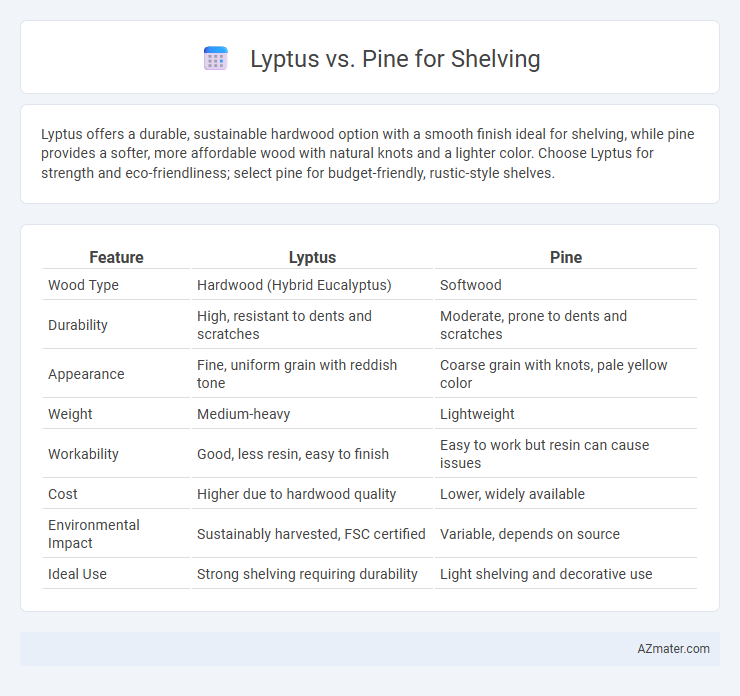Lyptus offers a durable, sustainable hardwood option with a smooth finish ideal for shelving, while pine provides a softer, more affordable wood with natural knots and a lighter color. Choose Lyptus for strength and eco-friendliness; select pine for budget-friendly, rustic-style shelves.
Table of Comparison
| Feature | Lyptus | Pine |
|---|---|---|
| Wood Type | Hardwood (Hybrid Eucalyptus) | Softwood |
| Durability | High, resistant to dents and scratches | Moderate, prone to dents and scratches |
| Appearance | Fine, uniform grain with reddish tone | Coarse grain with knots, pale yellow color |
| Weight | Medium-heavy | Lightweight |
| Workability | Good, less resin, easy to finish | Easy to work but resin can cause issues |
| Cost | Higher due to hardwood quality | Lower, widely available |
| Environmental Impact | Sustainably harvested, FSC certified | Variable, depends on source |
| Ideal Use | Strong shelving requiring durability | Light shelving and decorative use |
Introduction to Lyptus and Pine as Shelving Materials
Lyptus is a fast-growing hardwood hybrid derived from Eucalyptus species, known for its durability and fine grain, making it a popular choice for high-quality shelving. Pine, a softwood species common in North America, offers affordability and ease of workability but is more prone to dents and scratches compared to hardwoods. Both materials provide distinct aesthetic options, with Lyptus exhibiting a rich reddish hue while pine showcases a lighter, natural wood tone suitable for various shelving styles.
Appearance and Aesthetic Differences
Lyptus wood features a fine, uniform grain with a consistent reddish-brown hue that darkens slightly over time, offering a rich and modern aesthetic ideal for contemporary shelving. Pine displays a lighter, creamy color with distinct knots and a more pronounced, rustic grain pattern, lending shelves a warm, natural, and traditional appearance. The smooth texture of Lyptus allows for a sleek finish, while Pine's varied grain and imperfections create a more casual, organic look.
Strength and Durability Comparison
Lyptus wood offers superior strength and durability compared to pine, boasting higher density and hardness that resist dents and scratches more effectively. Pine, being a softer wood, is more prone to warping and damage under heavy loads, making it less ideal for long-term shelving use. The natural resilience of Lyptus ensures shelves maintain structural integrity and aesthetic appeal over time, outperforming pine in heavy-duty applications.
Workability and Ease of Installation
Lyptus offers superior workability for shelving due to its fine, uniform grain and consistent density, allowing for clean cuts, smooth sanding, and precise joinery. Pine's softer texture makes it easier to shape and drill, but it is more prone to dents and splintering during installation. Both woods are lightweight, though Lyptus provides a sturdier, more durable surface that withstands wear better in high-use shelving applications.
Cost Analysis: Lyptus vs Pine
Lyptus wood typically costs more per board foot compared to pine, due to its faster growth cycle and sustainable sourcing, making it a mid-range priced hardwood option. Pine, being a softwood, is generally more affordable and widely available, resulting in lower initial costs for shelving projects. When factoring in durability and resistance to warping, Lyptus may offer better long-term value despite higher upfront expenses.
Sustainability and Environmental Impact
Lyptus, sourced from fast-growing Eucalyptus trees, offers a sustainable alternative as it grows rapidly and requires less water and pesticides compared to traditional timber. Pine, widely available and renewable, often comes from managed forests but may involve slower growth cycles and chemical treatments that impact its environmental footprint. Choosing Lyptus for shelving supports eco-friendly practices through efficient land use and reduced harvesting pressures on natural forests, enhancing long-term sustainability.
Finishing and Maintenance Requirements
Lyptus wood offers a smooth, consistent grain that takes stains and finishes evenly, creating a sleek appearance ideal for modern shelving. It requires moderate maintenance, benefiting from regular dusting and occasional polishing to preserve its polished look. Pine, characterized by its softer texture and prominent knots, demands more frequent refinishing and careful sealing to prevent dents and moisture damage.
Suitability for Different Shelving Applications
Lyptus offers high density and uniform grain, making it ideal for heavy-duty shelving that requires durability and resistance to wear, such as industrial or garage storage. Pine, with its lighter weight and softer texture, is better suited for decorative or light-load shelving in residential settings where aesthetic appeal and ease of customization are priorities. Both woods provide decent stability, but Lyptus outperforms pine in strength, supporting heavier items without warping or sagging.
Pros and Cons of Lyptus Shelving
Lyptus shelving offers superior durability and resistance to dents compared to pine, making it ideal for high-traffic or heavy-use areas. The hardwood's smooth, fine grain provides an aesthetically pleasing finish and requires less maintenance, but it is generally more expensive than traditional pine. However, Lyptus is less flexible than pine, which can make it more prone to cracking under extreme stress or improper installation.
Pros and Cons of Pine Shelving
Pine shelving is highly favored for its affordability and natural knotty appearance, adding rustic charm to interiors while being lightweight and easy to work with. However, pine is softer than hardwoods like lyptus, making it more prone to dents, scratches, and wear over time, which can affect durability. It also absorbs stains and finishes unevenly, requiring careful sealing to prevent warping or discoloration in humid environments.

Infographic: Lyptus vs Pine for Shelving
 azmater.com
azmater.com